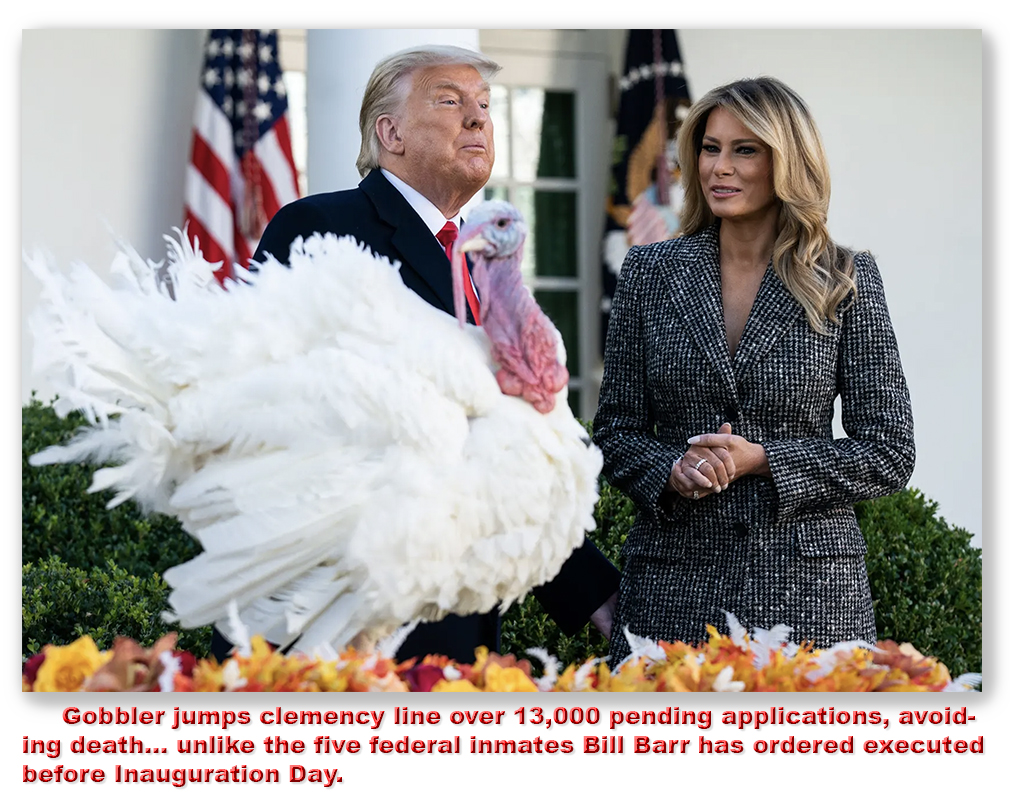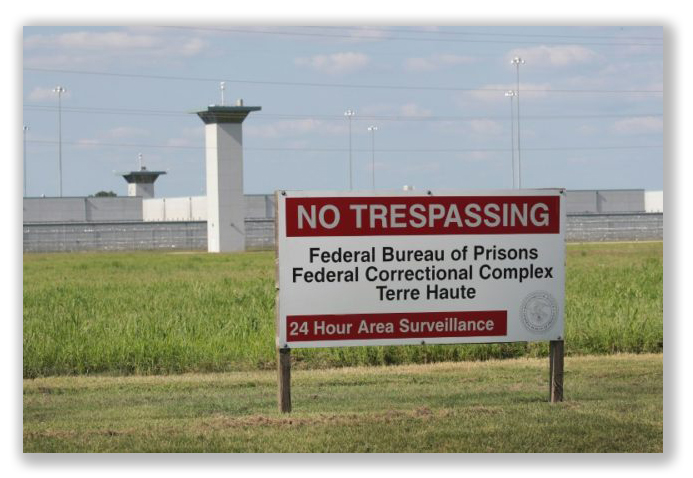We post news and comment on federal criminal justice issues, focused primarily on trial and post-conviction matters, legislative initiatives, and sentencing issues.

HOW BAD IS COVID?
Despite the 11th-hour Supreme Court petitions, the celebrity protests, the scathing editorials, nothing has stopped the Trump Administration’s headlong rush to execute federal inmates. Thirteen have been executed this century, 10 of them in the last six months.
Then came COVID.
President-elect Joe Biden has promised to halt the lethal injections, but three more were scheduled to die this week until last Tuesday, when SD Indiana Judge Jane Magnus-Stinson ruled that the federal government’s poor management of the previous 10 executions “has created a substantial risk” that other inmates and staff may contract the virus.
The judge got promptly overruled by higher-ups, so the death march continued with killing Lisa Montgomery two days ago. The government plans on doing in two more inmates between today and next Wednesday at noon, when the new President stops it.
 For the BOP to be able to carry out the remaining executions, the judge ruled, it has to create a contact log that tracks staff who come into close contact with others during the execution process. For 14 days after the execution, execution staff have to take daily rapid COVID-19 tests, and anyone who produces a positive test must go through contact tracing. “The defendants have touted the availability of testing but have chosen not to utilize rapid testing of staff and visitors who enter prison grounds,” the judge wrote. “Most disconcerting, the defendants represented to the Court that contact tracing would occur after any BOP staff member involved in the executions tested positive. This has not been the case—and the Court finds the failure was not by accident but by design.”
For the BOP to be able to carry out the remaining executions, the judge ruled, it has to create a contact log that tracks staff who come into close contact with others during the execution process. For 14 days after the execution, execution staff have to take daily rapid COVID-19 tests, and anyone who produces a positive test must go through contact tracing. “The defendants have touted the availability of testing but have chosen not to utilize rapid testing of staff and visitors who enter prison grounds,” the judge wrote. “Most disconcerting, the defendants represented to the Court that contact tracing would occur after any BOP staff member involved in the executions tested positive. This has not been the case—and the Court finds the failure was not by accident but by design.”
COVID might have been stymied at stopping the intentional killing, but it remains adept at bringing death to inmates. The number of dead inmates hit 198 last Friday. Inmate COVID cases fell 25% between Dec 31 and last Wednesday, but then jumped back up to 6,227 as of Friday. They started falling again (as the BOP continues to declare anyone who tested positive 10 days ago to be cured), settling at 5,043 yesterday.
Ominously, BOP staff cases continue to climb. The number crossed 2,000 for the first time ever last week, and stood at 2,107 yesterday. If the staff keeps getting sick, more inmates invariably will contract it as well.
As of yesterday, FCI Ft Dix reported 461 cases, with Lexington (444 cases), Butner Medium II (208 cases) and nine other facilities with more than 100 cases each, with 19 more having 50 or more cases.
The BOP’s vaccine program is not going all that well. Government Executive reported last week that the Bureau “has received just 12,800 vaccine doses, but has already used 57% of those.” The BOP has distributed the vaccine to only 31 of its roughly 150 facilities. COs and health care workers are receiving the vaccine in the BOP’s first phase of distribution, although some inmates have gotten vaccines when stocks remained after all employees who elected to get vaccinated had been served. Only about “half of staff at each of the 31 facilities receiving vaccines have so far been vaccinated, according to Justin Long, a bureau spokesman. Inmates will begin receiving doses when more become available under a plan developed by the Trump administration’s Operation Warp Speed, Long said.”
Meanwhile, a national debate is brewing over whether inmates should be inoculated before the general population. Health officials say inoculating prison employees without giving the shot to prisoners won’t help stop the spread. “It doesn’t make sense to vaccinate workers but not vaccinate the people they are charged with protecting,” said Wanda Bertram, a spokeswoman for the Prison Policy Initiative, which is advocating that staff and inmates receive the vaccine.
 But a typical reaction came from Colorado Gov. Jared Polis, a Democrat, who said last month, “There’s no way it’s going to go to prisoners before it goes to people who haven’t committed any crime.”
But a typical reaction came from Colorado Gov. Jared Polis, a Democrat, who said last month, “There’s no way it’s going to go to prisoners before it goes to people who haven’t committed any crime.”
Meanwhile, the Minnesota ACLU accused FCI Waseca staff of showing deliberate indifference to inmates during a massive COVID-19 outbreak in a hearing last Wednesday. The ACLU represents a plaintiff class of inmates seeking a temporary injunction to release many Waseca inmates to home confinement to curb the spread of the outbreak.
ACLU lawyer Clare Diegel called it a “drastic remedy” but necessary because of “terrifying” conditions at the prison. But Erin Secord, an AUSA representing the BOP, insisted the prison had taken numerous steps to protect inmates, the infections had been quelled and the court lacked jurisdiction to release prisoners. She said the suit should be dismissed.
 The president of a union representing employees at FCI Williamsburg in South Carolina last week blamed prison leadership for decisions that led to skyrocketing COVID-19 cases there. ”They made some changes on the process of what we were doing… that allowed COVID to actually walk into the institution,” American Federation of Government Employees’ Local 525 President Stephen Pinckney said. “From there, it spread like wildfire once it got in.”
The president of a union representing employees at FCI Williamsburg in South Carolina last week blamed prison leadership for decisions that led to skyrocketing COVID-19 cases there. ”They made some changes on the process of what we were doing… that allowed COVID to actually walk into the institution,” American Federation of Government Employees’ Local 525 President Stephen Pinckney said. “From there, it spread like wildfire once it got in.”
Pinckney alleged that the process of screening people entering the complex to determine whether they had potential symptoms of COVID-19 symptoms was shifted from outside the facility to inside in early December. “I really would like to see our executive staff removed for one thing because they are more concerned right now on the financial side of the institution that they are about the health and wellbeing of staff there,” Pinckney said.
Indianapolis Star, Terre Haute executions paused by judge until COVID-19 measures are instituted (January 8, 2021)
Government Executive, Federal Agencies Have Distributed 200K Coronavirus Vaccine Doses So Far (January 4, 2021)
Wall Street Journal, As Covid-19 Surges in Jails, Guards Want Vaccine Early (January 4, 2021)
WCSC-TV, Charleston, South Carolina, Prison workers union calls for action on COVID-19 outbreak at FCI Williamsburg (January 8, 2021)
– Thomas L. Root











